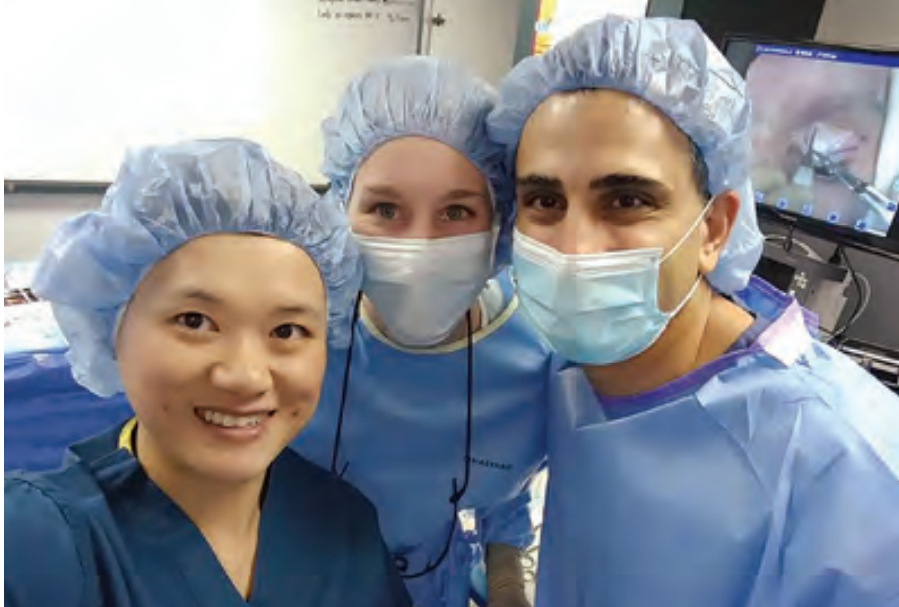Dr. Zoumalan recently participated in USC School of Medicine’s annual Oculofacial Anatomy Course, an anatomy course that has become a very popular and well-received instructional program for residents and fellows in Ophthalmology and Oculoplastic Surgery. The course, which was founded and directed by Dr. Sandy Zhang-Nunes, one of Dr. Zoumalan’s colleagues, is a complete two-day, hands-on cadaver course that takes the members through eyelid anatomy, orbital anatomy, and into eyelid surgeries such as blepharoplasty surgery, ptosis surgery, ectropion surgery, and onto complex orbital and tear duct surgery. Experts rotate between fully equipped surgical stations filled with all the necessary oculoplastic instruments such as an endoscope, a drill, ultrasonic aspirator, and plating material to ensure a well-rounded learning environment. The course also consists of brief lectures where attendees learn new approaches and hone in their skills to improve patient care.
It has brought together renowned faculty, many residents, as well as the American Society of Ophthalmic Plastic and Recovery Surgery fellows and visiting scholars from all over the world to participate and learn from another. Dr Zoumalan is one of the faculty members of the course, lecturing on various topics, and providing live-demonstrations of the surgeries to the attendees. Dr. Zoumalan relays his experience, “This course is incredibly fulfilling in so many ways. It’s one of my favorite teaching events of the year. I get to collaborate and share ideas with some of the most renowned and well-respected Oculoplastic surgeons, and together, we all teach the younger generations about our field. It’s truly an honor to be part of this A+ team.”
Dr Zoumalan regularly works with the residents and fellows at USC. He spends time in the operating room with the residents and fellows supervising complex eyelid and orbital surgeries on a regular basis.
The Importance of Oculofacial Surgery
For many reasons, the skills required to perform oculofacial surgery and its variety of procedures are critical as they can be used for both the medical and cosmetic needs of patients. Certain eyelid and periocular issues can affect a patient’s peripheral vision, eye health, and their appearance. This is why an oculoplastic surgeon takes additional formal training to focus on eyelid abnormalities, problems in tearing, and orbital disease. In some cases, the benefits of eyelid surgery can greatly benefit a patient’s quality of life. Ectropion and entropion repair work to correct eyelids that fold inward or turn outward. External dacryocystorhinostomy restores the flow of tears and ptosis repair corrects drooping of the lower eyelid, upper eyelid, and other conditions that cause eyelid infection or trauma. These procedures can cover a range of eye issues; orbital surgery, for instance, manages eye disorders, tumors, thyroids, loss of vision and trauma to the eye.
According to the American Society of Ophthalmic Plastic and Recovery Surgery, blepharoplasty is one of the top five cosmetic surgeries performed. In 2012, over 200,000 blepharoplasty procedures were performed in the United States. Due to so many oculoplastic surgeries being performed, a large number of board-certified and capable oculoplastic surgeons are needed to ensure their patients are safely and professionally cared for when undergoing their eyelid surgery.
The Importance of Higher Education
The USC Oculofacial Anatomy Course was able to offer an environment where renowned faculty, residents, and many guests from around the world could come together to learn from one another in how best to treat and care for patients by utilizing the latest in oculofacial techniques. Eyelid surgery offers so many benefits to a number of patients and can improve their lives in so many ways that other facial procedures cannot fulfill. The higher education courses provided at USC School of Medicine have the future in mind by teaching the younger generation of oculoplastic surgeons a variety of necessary surgeries through hands-on lessons and lectures conducting by experts in their fields. This hands-on approach to learning, a fundamental aspect of higher education, creates a space for optimal engagement between the students and faculty with the equipment and techniques being used in the lessons. Higher education also promotes sharpening skills even from its well-respected educators because it is a place for constant education and moving forward in bringing about the highest form of care for patients.
The experience facilitated at this year’s annual Oculofacial Anatomy Course is a guide for all forms of higher education to create a controlled environment specifically for joining together and learning as one. This all encompasses space for learning demonstrates a promising future for the medical field and the world.
To find out more about cosmetic eyelid surgery and other oculoplastic procedures, contact us today!


